Ever had one of those days where you just need a big bowl of something warm, creamy, and soul-soothing? Yeah, me too. That’s why Chicken Potato Soup is my go-to comfort dish. According to a recent survey, 71% of people consider chicken soup the ultimate feel-better meal. But this isn’t your average broth-based bowl—it’s thick, flavorful, and loaded with goodness. Let’s dive into this cozy classic with a creamy twist!

Ingredients for Chicken Potato Soup
Getting the ingredients right for chicken potato soup isn’t just step one—it’s everything. I’ve made this soup more times than I can count, and I’ll be honest: I’ve messed it up just as often. One time I used the wrong kind of potato and ended up with a gluey, bland mess. Another time I tried to use dry leftover chicken breast—big mistake. This recipe taught me that simple food still needs smart choices.
Best Potatoes for Soup
Potatoes seem easy, right? Just throw ‘em in? Nope. The type of potato totally changes the texture of your soup. Yukon Gold potatoes are my go-to because they’re creamy, tender, and hold their shape without turning into baby food. They also naturally thicken the broth, which means I don’t have to use a ton of cream. I’ve tried russet potatoes too, and while they’re great for baked potatoes, they tend to fall apart if you simmer them too long. That’s okay if you want a chowder vibe, but not great if you like bite-sized chunks.
Red potatoes? Forget it. I used them once because it’s what I had on hand. They looked fine at first but after 20 minutes in the pot, they turned into a gummy paste. Lesson learned.
Chicken Choices That Work
Now for the star of the show—chicken. I used to think boneless skinless chicken breasts were the way to go. But they dry out fast. Thighs, on the other hand, stay juicy, even after simmering. They also give the broth a richer flavor. I usually go with boneless, skinless thighs to keep things easy, but bone-in adds even more depth if you’ve got the time.
That said, sometimes I cheat and use rotisserie chicken. It’s already cooked and seasoned, and I just shred it and throw it in during the last five minutes. It saves me time and still tastes amazing, especially if I build the rest of the soup with good aromatics and herbs.
Flavor Boosters You Shouldn’t Skip
Here’s where a lot of people go wrong. They just toss everything into a pot and hope for the best. Nope. You gotta build the flavor from the ground up. I always start by sautéing chopped onions, garlic, and sometimes celery in a little butter or olive oil. This gets your base going and makes the kitchen smell like heaven.
Then I layer in dried herbs—thyme, rosemary, maybe some parsley. A bay leaf adds that classic soup taste. Don’t skip it. A dash of smoked paprika gives the soup a whisper of warmth and color, and if I’m feeling bold, I’ll add a pinch of cayenne. Not enough to make it spicy, just enough to wake up your taste buds.
And let’s not forget salt. Taste as you go. Undersalted soup is one of those things that seems fine until you’re halfway through your bowl and wondering why it’s so… meh.
Optional Add-ins That Take It Further
Some days, I get creative. A handful of frozen corn adds sweetness and texture. Crumbled bacon on top? Yes, please. If you’ve got cheddar cheese, a little sprinkle when serving makes it super comforting. And if you want it even creamier, stir in a splash of heavy cream or half-and-half right before serving. But you don’t need much—this soup already has body from the potatoes and chicken fat.
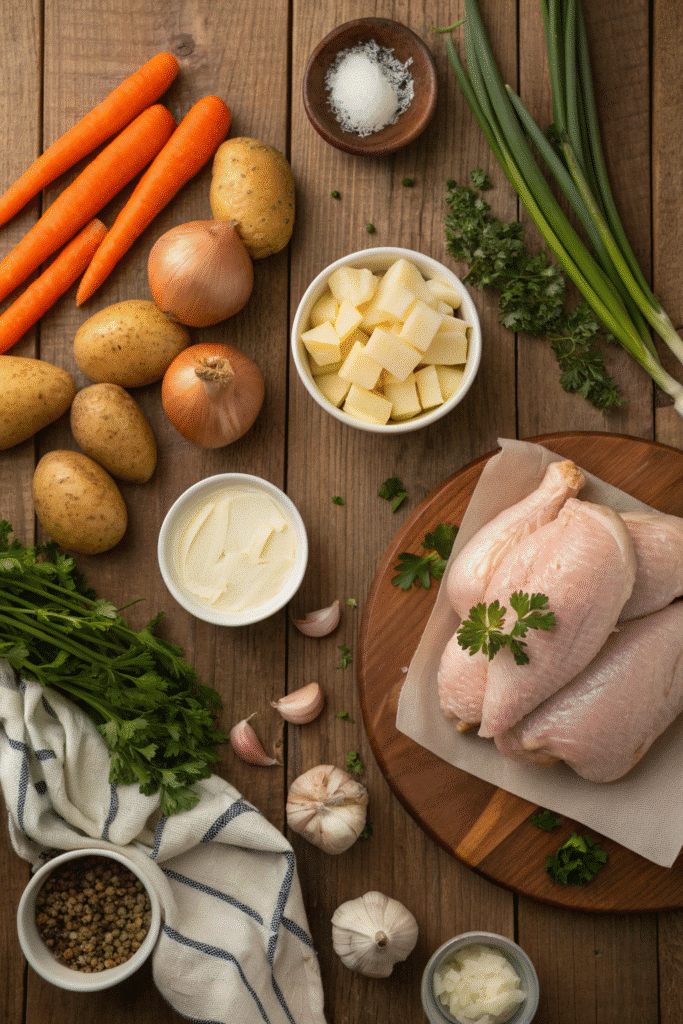
Step-by-Step Cooking Instructions
If there’s one thing I’ve learned about making chicken potato soup, it’s that rushing the process ruins the magic. I used to just dump everything into the pot, crank up the heat, and hope for the best. Yeah… don’t do that. The secret to rich flavor and perfect texture? Building it layer by layer. Trust me, it’s worth every minute.
Start with the Aromatics
This part’s non-negotiable. Melt some butter or heat olive oil in your pot and toss in finely chopped onions. Let them go until they’re soft and just turning golden. Not burnt—just enough to smell sweet. Add garlic right at the end so it doesn’t scorch. If you’re using celery, this is when to throw it in too. This trio sets the base flavor for the whole soup.
I once skipped this step thinking it wouldn’t make a difference. The result? Bland and boring. Never again.
Add the Potatoes and Broth
After your aromatics are soft and fragrant, stir in your diced potatoes. Don’t overcrowd them. I usually go with small cubes so they cook evenly. Stir everything together so the flavors coat the potatoes.
Then comes the broth. You can use chicken stock for a deeper flavor, or broth if that’s what you have. I prefer low-sodium so I can control the salt. Pour it in slowly, scraping the bottom of the pot to catch any browned bits—that’s liquid gold right there. Bring it to a simmer and let it bubble gently. Don’t boil like a maniac or your potatoes will break down too fast.
Chicken Time: Raw vs. Pre-Cooked
If you’re starting with raw chicken, this is the time to add it. I cut boneless thighs into bite-size pieces and simmer them with the potatoes. They stay tender and soak up all the herby goodness.
If you’re using pre-cooked or rotisserie chicken, hold off. Add it during the last few minutes of cooking so it doesn’t dry out or fall apart.
Add Cream at the End—Don’t Rush It
Want that silky, creamy finish? Wait until everything is fully cooked. Then drop the heat to low and stir in heavy cream, half-and-half, or even evaporated milk. If you add it too early or when the soup’s still boiling, it can curdle or separate. Been there, done that—ruined a whole pot once. Learn from my mistake.
Also, if the soup looks too thin, mash a few potato chunks with the back of your spoon. It thickens it naturally without needing flour or cornstarch.
Taste, Adjust, Repeat
Before serving, taste. Always. Add more salt, maybe a bit of pepper or a squeeze of lemon if it feels flat. Every pot is different. Some days, mine needs extra thyme. Other days, it’s begging for garlic powder. Don’t be afraid to play.
Soup isn’t just about following a recipe—it’s about trusting your gut. And once you nail the rhythm of this method, you won’t even need to look at a recipe again.
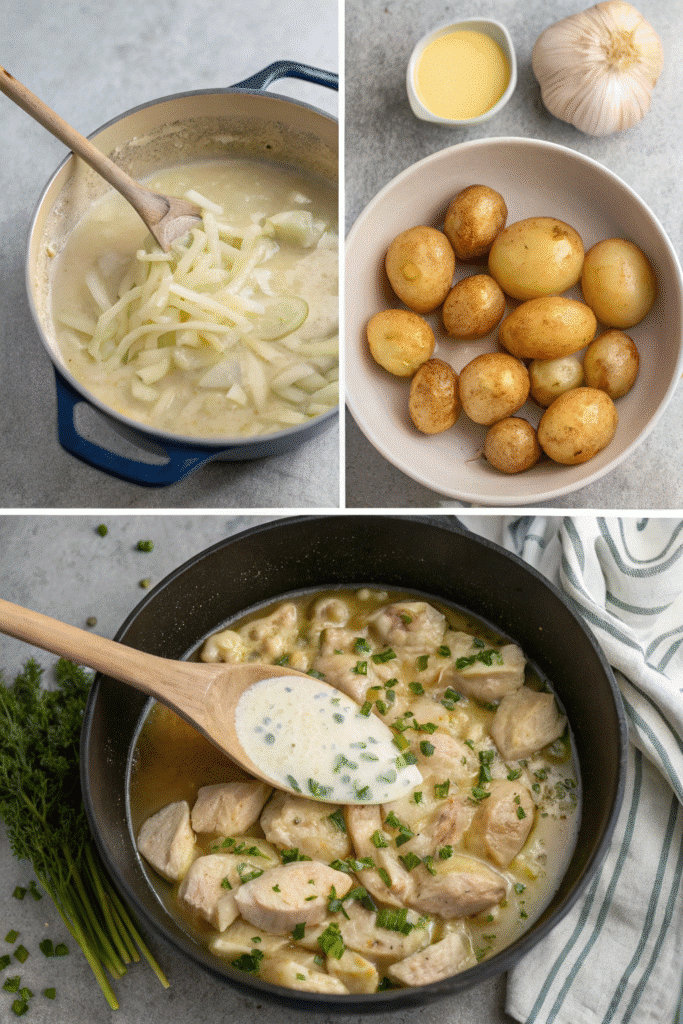
Tips for the Perfect Texture and Flavor
I used to think chicken potato soup was foolproof. Just throw stuff in a pot, right? But my early batches taught me otherwise. Either the potatoes turned to mush, the broth was bland, or it came out more like stew than soup. Over time—after a few near-disasters—I figured out a handful of tricks that seriously changed my game. If you want that just-right balance of creamy and chunky, flavorful without being salty, these tips make all the difference.
Don’t Overcook the Potatoes
This is probably the number one mistake people make. Potatoes keep cooking even after you turn off the heat, especially if you let the soup sit in a hot pot. I try to pull the pot off the stove when the potatoes are just fork-tender—not falling apart. Usually around 12–15 minutes of simmering. Anything more, and you’re heading toward mashed soup territory.
One trick I learned? Cut the potatoes evenly. It sounds simple, but uneven chunks cook at different rates. I used to rush this and end up with a weird mix of undercooked and disintegrated pieces.
Layer Seasoning—Don’t Dump It All at Once
Flavor isn’t just about tossing in salt and pepper. It’s about building. I season my onions while they’re sautéing, then again once I add the broth, and one more time before serving. And always taste. My husband once made this soup while I was sick, and bless him, but he added all the herbs at the end—it tasted like garden water.
Start with dried thyme and bay leaf early on so they steep into the broth. Finish with fresh parsley or a pinch of garlic powder to boost what’s already there. Don’t be afraid to adjust. Soup should evolve as it cooks.
Use Chicken Fat—Seriously
If you’re trimming chicken thighs, save that little bit of fat and render it down before you cook the onions. That stuff adds way more flavor than oil. It gives the soup a savory backbone that butter just can’t match. I only learned this after watching an old-school French cooking video. Changed everything.
Balance the Creaminess
You don’t need a ton of cream to get a creamy soup. Between the starch from the potatoes and the richness of the chicken, just a splash of cream or milk is enough. I also mash a few potatoes right in the pot to thicken it naturally. If you want it silky smooth, you can blend a cup or two and stir it back in. But don’t go overboard—it’s not supposed to be chowder.
The Final Touches Matter
Right before serving, I like to add a squeeze of lemon or a splash of vinegar—just a bit. It brightens everything. And a pinch of salt at the end pulls all the flavors together. Trust your tongue. If it tastes flat, it probably needs acid, not more seasoning.
Oh, and never forget the fresh herbs. Even if it’s just chopped parsley or green onions on top—it adds color, freshness, and makes it look like you know what you’re doing.
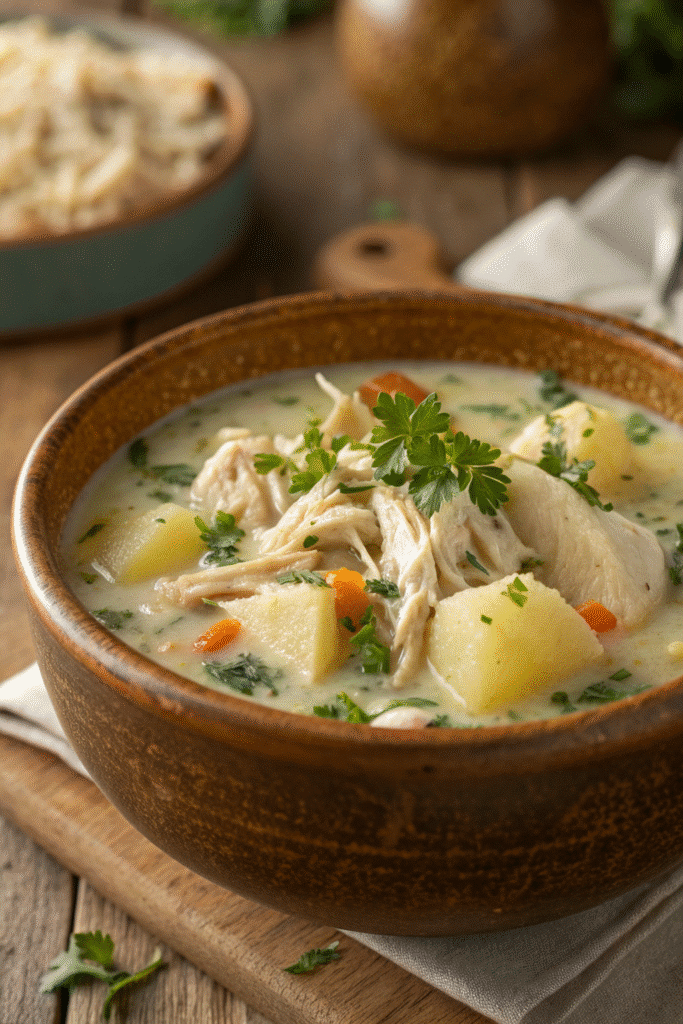
What to Serve with Chicken Potato Soup
Here’s the thing—chicken potato soup can absolutely stand on its own. It’s rich, hearty, and cozy enough to be the whole meal. But when you pair it with the right sides? Chef’s kiss. It turns dinner into something kinda special. I didn’t used to think about sides much—just grabbed whatever bread was closest. But I’ve learned that the right pairing brings out flavors in the soup I didn’t even know were there.
Bread is Non-Negotiable
Let’s start with the obvious. You need bread. I’ve tried this soup with everything from sandwich slices to fancy sourdough, and honestly, crusty bread wins every time. A warm baguette, split and slathered with butter, is my go-to. Garlic toast is another crowd-pleaser—just rub a raw clove on toasted bread, drizzle with olive oil, and boom: fancy dinner.
And biscuits? Absolute comfort food combo. Especially if they’re flaky and slightly sweet. One time I made cheddar biscuits and dunked them into the soup—felt like I was eating at a farmhouse café.
Fresh Salad Balances It Out
Since the soup’s creamy and hearty, a crisp salad makes a great contrast. I usually throw together mixed greens, cucumbers, and a lemon vinaigrette—nothing heavy. You want something bright to cut through all that richness. Arugula with thin-shaved parmesan and a light dressing is another good one. Even just sliced tomatoes with salt and olive oil works in a pinch.
Funny enough, I used to skip salad entirely. Thought it was too much effort. But once I added it to the table, the whole meal felt… lighter somehow. More complete.
Drinks That Pair Well
A bowl of soup might not scream wine night, but hear me out. A chilled glass of white wine—something crisp like Sauvignon Blanc—actually works wonders with the creamy texture of the soup. If I’m keeping things simple, I go for apple cider or even iced tea. On colder nights, I’ve served this soup with hot spiced tea or a light beer. Works like a charm.
For kids or non-drinkers, lemon water with a splash of honey is surprisingly great. Helps cut the richness and adds just a bit of sweetness.
Comfort Food Add-Ons
Sometimes, especially in the fall or winter, I go all out. I’ll bake a small batch of cornbread muffins or roasted veggies on the side. Roasted carrots or Brussels sprouts are perfect. You could even make a grilled cheese if you’re feeling indulgent—sharp cheddar, sourdough, pan-fried in butter. My nephew once called it “the ultimate soup dinner” and I’m not gonna argue with that.
It doesn’t have to be fancy. But taking a few minutes to think about what you serve with your chicken potato soup really makes the meal feel complete. And that little bit of extra effort? Totally worth it.
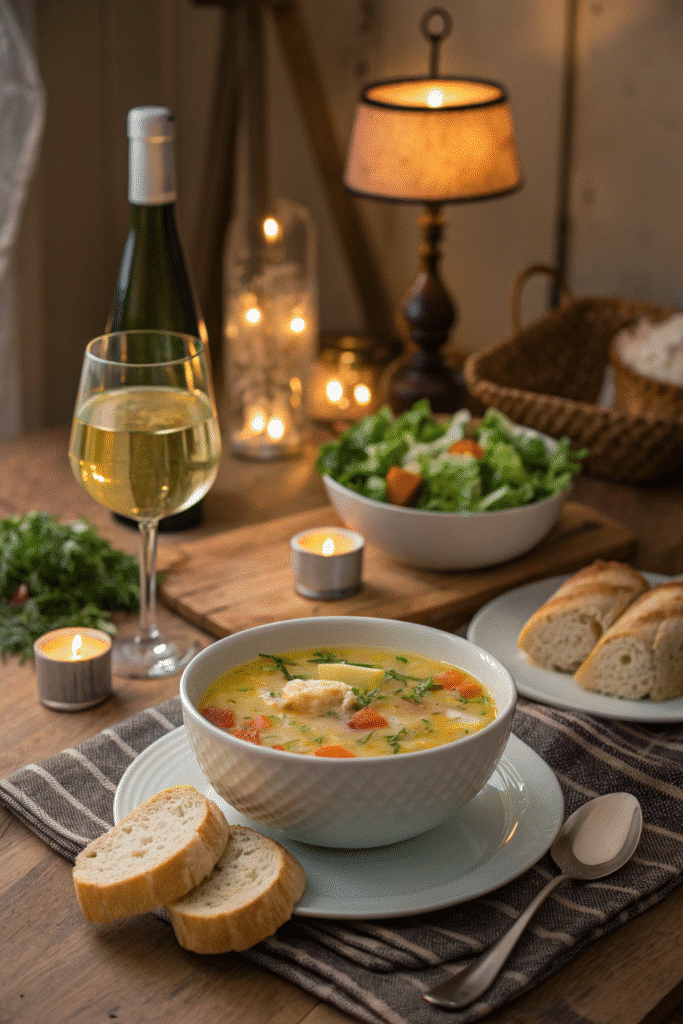
Storing and Freezing Leftovers
I used to think soup didn’t need any special treatment when it came to storing—just toss it in the fridge and forget about it. But chicken potato soup has a few quirks that can either keep it amazing the next day… or turn it into a grainy, separated mess. Trust me, after one too many disappointing reheats, I’ve learned a few tricks that make leftovers just as satisfying as the fresh pot.
Cool It Down the Right Way
First thing—don’t shove a hot pot of soup straight into the fridge. I’ve done that, and not only did it warm up everything else in there (sorry, yogurt), but it also messed with the texture of the soup. Let it cool on the counter for 30–60 minutes, then move it to shallow containers. I like glass better than plastic, just because it doesn’t stain or hold weird smells.
And if you’re planning to freeze it, don’t add the cream just yet. Creamy soups can separate after freezing, so I usually freeze the base without dairy and stir in the cream after reheating. Learned that one the hard way—ended up with a curdled, grainy disaster I wouldn’t wish on anyone.
How Long It Lasts in the Fridge
When stored properly in airtight containers, chicken potato soup holds up in the fridge for about 3 to 4 days. That’s the sweet spot. After that, the potatoes start to break down and the flavor dulls out. I try to portion it out ahead of time, so I don’t keep opening the same container over and over.
Also, label your containers. I can’t count how many times I thought I had chicken soup, only to open it and find something totally random like leftover chili.
Freezing Tips for Later
Yes, you can freeze chicken potato soup—but again, skip the cream if you can. Let the soup cool completely, ladle it into freezer-safe containers (leave a bit of space at the top for expansion), and label it with the date. I also portion it into single servings so I don’t have to thaw a whole batch just for lunch.
It’ll keep in the freezer for up to 3 months. When you’re ready to eat, thaw it overnight in the fridge, then warm it gently on the stove. Add your cream or milk at the end, stir it through, and you’re good to go.
Reheating Without Ruining It
Microwaving works fine if you’re in a hurry—just use medium power and stop to stir every 30 seconds or so. But the stovetop gives you more control. Heat it slowly over medium-low, stirring often to keep things smooth. If it looks too thick, add a splash of broth or milk. If it looks separated, stir like your dinner depends on it—because it does.
The big takeaway? Chicken potato soup is freezer- and fridge-friendly, but only if you treat it with a little care. Done right, your leftovers will taste like they just came off the stove.
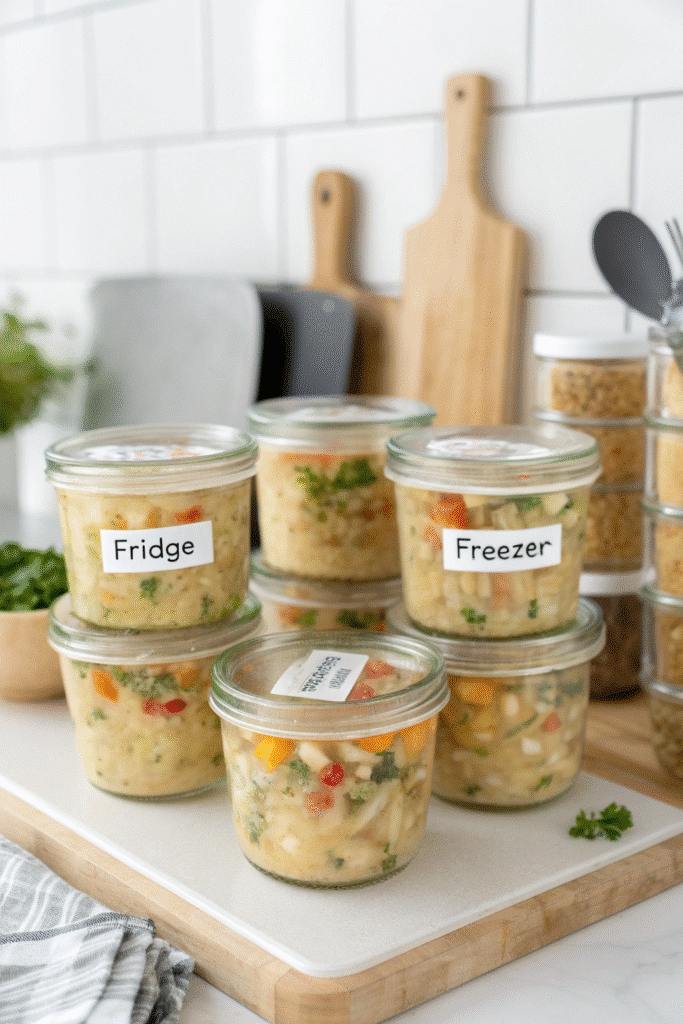
Chicken potato soup isn’t just another recipe. It’s the kind of meal that wraps around you like a blanket on a cold day. I’ve made it in every mood—tired, stressed, happy, broke—and it always hits the spot. There’s something about the combination of tender chicken, creamy potatoes, and a well-seasoned broth that just works. No matter how chaotic life feels, this soup reminds me that simple food, made with care, is enough.
If there’s one thing I’ve learned, it’s that the small stuff matters. Using Yukon Golds instead of whatever’s in the pantry. Letting the onions get soft and golden before tossing everything else in. Holding back the cream till the end. These things seem tiny—but they turn good soup into amazing soup.
And honestly? Making this soup over and over again taught me to slow down. You can’t rush a simmer. You can’t shortcut comfort. But you can share it. So if you made it, enjoyed it, or added your own twist, I’d love it if you pinned this recipe to Pinterest. Share it with a friend. Text it to your cousin who’s having a rough week. Recipes are meant to be passed on.
Because sometimes, the best things in life are just a warm bowl of soup—and someone to enjoy it with.
Print
Chicken Potato Soup Recipe 2025: Creamy, Cozy, and Comforting!
A warm, creamy, and soul-soothing chicken potato soup loaded with tender chicken, Yukon Gold potatoes, and rich flavor from aromatics and herbs.
- Total Time: 45 minutes
- Yield: 6 servings 1x
Ingredients
- 2 tablespoons butter or olive oil
- 1 medium onion, finely chopped
- 3 cloves garlic, minced
- 2 celery stalks, diced (optional)
- 4 Yukon Gold potatoes, diced
- 4 cups low-sodium chicken broth
- 1 ½ pounds boneless skinless chicken thighs (or shredded rotisserie chicken)
- 1 bay leaf
- 1 teaspoon dried thyme
- ½ teaspoon dried rosemary
- ½ teaspoon smoked paprika
- Salt and pepper, to taste
- ½ cup heavy cream or half-and-half
- Fresh parsley or green onions, chopped (for garnish)
- Optional: frozen corn, crumbled bacon, shredded cheddar cheese
Instructions
- Heat butter or olive oil in a large pot over medium heat. Sauté onion until soft and golden. Add garlic and celery (if using) and cook briefly.
- Stir in diced potatoes and coat with aromatics.
- Pour in chicken broth, scraping up any browned bits from the pot. Add bay leaf, thyme, rosemary, smoked paprika, salt, and pepper.
- If using raw chicken thighs, cut into bite-size pieces and add now. Simmer gently for 12–15 minutes until potatoes are fork-tender and chicken is cooked through.
- If using pre-cooked or rotisserie chicken, add it during the last 5 minutes of cooking.
- Reduce heat to low. Stir in heavy cream or half-and-half. Mash a few potato chunks in the pot to thicken naturally.
- Taste and adjust seasoning with more salt, pepper, or a squeeze of lemon.
- Garnish with fresh parsley, green onions, crumbled bacon, or cheese before serving.
Notes
For best results, use Yukon Gold potatoes and chicken thighs. Don’t add cream until the end to avoid curdling. Leftovers can be refrigerated for 3–4 days or frozen (add cream after reheating).
- Prep Time: 15 minutes
- Cook Time: 30 minutes
- Category: Soup
- Method: Stovetop
- Cuisine: American
Nutrition
- Serving Size: 1 bowl
- Calories: 320
- Sugar: 3g
- Sodium: 720mg
- Fat: 15g
- Saturated Fat: 6g
- Unsaturated Fat: 8g
- Trans Fat: 0g
- Carbohydrates: 26g
- Fiber: 3g
- Protein: 22g
- Cholesterol: 95mg


